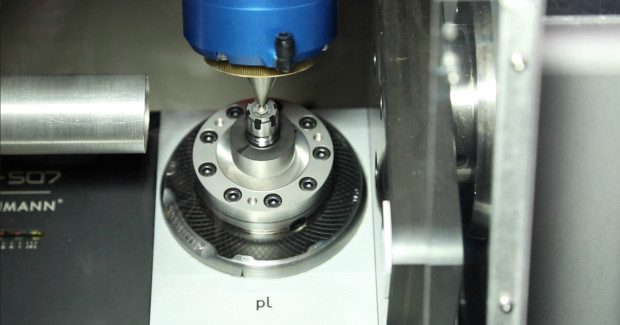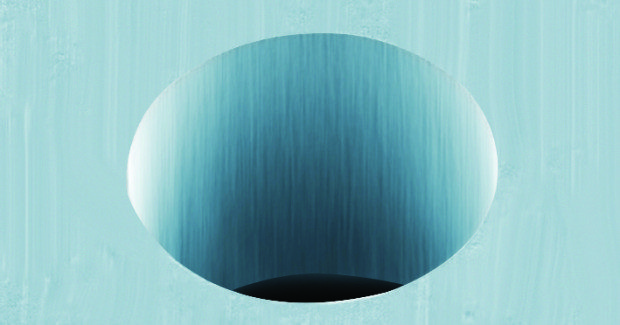Micromachining: No More Constraints
The latest femtosecond laser technology from Raydiance can reduce cost per part by 20 percent to 50 percent and reduce product design, prototyping and development from months to as little as 24 hours.
Posted: May 27, 2014
EDM is limited to conductive materials, i.e. it doesn’t work for tissue, polymers, or glass, plus it imparts significant heat deposit during the process. Conventional lasers offer a fair degree of precision, but there is always heat affected zone (HAZ). Heat produces material change through chemical reaction which is not tolerable. In some cases, it is possible to reduce defects by slowing down the conventional process. Is this acceptable? Usually, no.
The key to femtosecond laser micromachining is that the energy in each laser pulse is nearly 100 percent used for precisely removing material . . . there is no energy wasted as diffused heat or uncontrolled tearing or fracture. The R-Drill, R-Mill and R-Tube are the only ways to machine heat-sensitive materials – like tissue, polymers, and glass – as well as metals without imparting defects.
Using the R-Drill, industrial and medical manufacturers can capture production savings by drilling faster (< 1 sec through 1.2 mm 316 stainless steel) through thicker materials than previously before. They can now produce parts with intricate hole features not previously possible in an all-laser manufacturing process, including perfectly round holes, elliptical holes, square holes, positive and negative tapers, micron-sized entrance and exit features, and holes that alter shape and profile from the top to the bottom of the part.
And they can do all of this without months of iterative machine shop-based prototyping of new parts.
The R-TUBE: MEDICAL DEVICES
Medical device manufacturers can use the R-Tube to achieve unmatched strut-to-strut consistency in nitinol or polymer arterial and peripheral stents without the need for post processing.
Conventional picoseconds or nanosecond laser manufacturing methods often require multiple steps to correct processing defects, adding time and cost. But the R-Tube eliminates interior dimension (ID) honing, acid etch and bead blasting steps typical of other stent manufacturing processes, thereby delivering greater ROI. This means designers can expand their stent material choices and add new features, such as cutting-edge polymers for drug eluting stents with new drug retention reservoirs.
The R-MILL: DIFFICULT CHALLENGES
The R-Mill addresses the difficult challenge of creating micron-scale, complex features in medically relevant materials by enabling a wide array of manufacturers to resurface or retexture delicate materials, such as pericardial tissue used for heart valve applications or polymer-based catheter balloons to impart flexibility features and control movement.
Manufacturers can also introduce precision slots, grooves, tapers and edge effects to virtually any material or part including microfluidic applications, and optimize production economics through manipulations of process and material-specific variables, such as milling speed, ablation depth and milling pattern repetition.
INNOVATION NOW
These systems are now introducing innovative changes on the factory floor. The industry is witnessing the rapid adoption of femtosecond laser micromachining in applications such as drilling GDI fuel injector spray holes and cutting cardiovascular stents. The benefits in these applications were immediately obvious, like the 20 percent to 30 percent automobile fuel efficiency improvement and the substantially lower total cost of ownership for the manufacturer.
Once factories have the first series of tools, however, they usually identify multiple adjacent applications where the benefits are equally compelling. This drives the acceleration of features in these systems. In fact, the early success of the R-Drill for drilling zero-taper holes lead to development of the R-Mill for machining zero-taper slots and grooves.
Moreover, the R-Drill, R-Mill and R-Tube can each be reconfigured from job to job through software control. The delivery of laser light to the part is directed by a beam delivery system that is programmable. So shapes, surface figures and process speed can be rapidly iterated on the shop floor. Factories can leverage a print-to-part capability where the solution software automates the changes and new parts are fabricated in hours . . . not days or weeks as with previous machine tools.
In the continuing search for competitive advantage, micromachining systems now enable factories to: innovate from print to part; use faster development cycles and production ramps; take advantage of new adjacencies and system features; invest in cheaper, more powerful laser systems; and make better use of laser light when femto processing optimized.
Altogether, these dynamics on the shop floor are making micron-level precision manufacturing a deterministic and cost-effective option for whole portfolios of products in real time.
The R-Drill, R-Mill and R-Tube can solve today’s toughest precision manufacturing challenges, but they also impact product design on a much bigger level. Product advancement relies on breakthroughs in design engineering, materials, and fabrication capability. These systems help precision fabrication capability to catch up to the rapid pace of innovation in designs and materials.
With much more concurrent breakthroughs in all three areas, manufacturers will finally have the flexibility they need to bring more durable, lighter weight, and higher performance products to market . . . all with faster transition from development to production.







